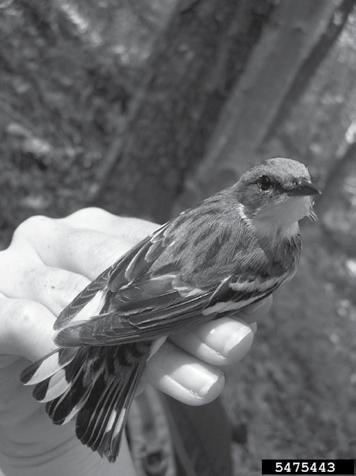
3 minute read
cker M
News from New York Tree Farm Program
Mary Jea e Pac er
Advertisement
Cerulean warbler (Setophaga cerulea) (Wilson,A, 1810) USDA Forest Service Southern Research Station , USDA Forest Service, SRS, Bugwood.org
2019 NYS Tree Farm Field Day: June 8
The NYS Tree Farm Program will be holding its Annual Tree Farm Field Day in the Upper Delaware Watershed this year and all NYFOA members are invited to attend. The event will take place on Saturday June 8 from 8 a.m. to 4 p.m. at the John A. Lennox Memorial Forest and Cornell Cooperative Extension of Delaware County’s 4-H Camp Shankitunk located in Delhi, NY. You can download the registration information from the NYS Tree Farm website, www.nytreefarm.org, or call the NY Tree Farm office, 518-854- 7386. Camping and rustic cabins are available on-site, for an additional fee, for the nights of June 7th and 8th.
The morning program will highlight the new Harvests for Habitat program and opportunities for family forest
South Central Forest Products, LLC
Mike Blasko
Consulting Forester & Private Forest Management PO Box 6, Greene, NY 13778 607-656-4759 (home) 607-373-9660 (cell) website: scforest.com
NYS DEC Cooperating Forester NYC Watershed Certified Forester Natural Resources Conservation Service – TSP • Over 20 Years Experience with
Private Landowners • Forest Tax Law • Timber Appraisals • Tree Planting • Boundary Location and
Maintenance • Wildlife Management • Timber Sales • Management Plans
owners to get involved. Harvests for Habitat is a partnership that began in 2018 in the Upper Delaware Watershed between Audubon NY, the Watershed Ag Council, and NY Tree Farm Program, with funding from National Fish and Wildlife Foundation and American Forest Foundation. It enables habitat improvements through active forest management and financial incentives. Also on the agenda is an update on the potential threat to NYS’s forests from the invasive spotted lanternfly presented by Sara Wurzbacher from Penn State University.
Resource tables and informational displays staffed by representatives of various forestry and natural resources conservations agencies and organizations will be set up all day at the camp. NYS DEC Pesticide Applicator recertification and SAF credits are pending approval.
After lunch, which is included with registration, the program moves outdoors for an educational forest management tour through some of the 18 blocks of the Lennox Model Forest’s silvicultural treatments. Included will be several units that demonstrate how the application of certain sustainable forestry practices can improve forest habitat conditions for at-risk bird species such as wood thrush, cerulean warbler, and many others. Similar forest management practices can be undertaken by forest owners in the Upper Delaware watershed utilizing incentives available through the Harvests for Habitat project.
Tree Farm Inspector Rod Jones from Northeast Timber Services in Walton is Lennox Forest’s forester, and will be leading the afternoon woodswalk. Jones says, “this field visit will be an excellent opportunity for forest owners to see firsthand what the outcomes of management activities look like after the harvest is completed.”
According to Audubon New York, “young forest habitat is an important component of a diverse and healthy forested landscape. Research from the past decade has confirmed that many birds that nest in mature forests preferentially use young forest as post-fledging habitat for their young, which appears to increase survival of fledglings. To have an intact forest breeding bird community, forested landscapes must include patches of young forest habitat. Young forest habitat can be created by appropriate application of even-age silvicultural techniques, such as clearcuts, clearcuts with reserves, and seed tree harvests.”
In the Lennox Forest compartment description, Jones writes about two stands totaling about 12 acres that will be part of the afternoon field visit that have been managed with an evenage prescription. “[These sections] of the Model Forest were originally reduced to 40-60 square feet of basal area back in our first entry in order to develop regeneration of high quality northern hardwoods. The larger trees that were left in the stand are excellent quality and the stand is developing a good amount of regeneration. The larger trees were removed in 2009. The advanced regeneration that is established has enough numbers of trees per acre to establish the next forest.”
Learn about the NY Tree Farm Program at www.nytreefarm.org or contact the office on 518-854-7386 or email nytreefarm@gmail.com
(814) 367-5916 email halefor@verizon.net










